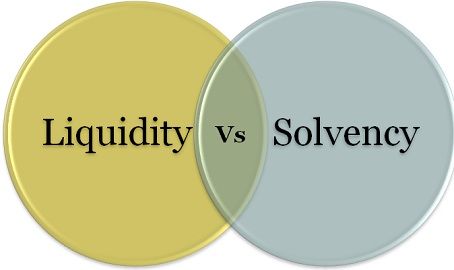 While liquidity is how effectively the firm is able to cover its current liabilities, through current assets. Solvency determines how well the company maintains its operation in the long run. At the time of making an investment, in any company, one of the major concerns of all the investors is to know its liquidity and solvency.
While liquidity is how effectively the firm is able to cover its current liabilities, through current assets. Solvency determines how well the company maintains its operation in the long run. At the time of making an investment, in any company, one of the major concerns of all the investors is to know its liquidity and solvency.
These are the two parameter which decides whether the investment will be beneficial or not. This is because these are related measures and helps the investors to carefully examine the financial health and position of the company.
For a layman, liquidity and solvency are one and the same, but there exists a fine line of difference between these two. So, take a glance at the article provided to you, to have a clear understanding of the two.
Content: Liquidity Vs Solvency
Comparison Chart
| Basis for Comparison | Liquidity | Solvency |
|---|---|---|
| Meaning | Liquidity implies the measure of the ability of the firm to cover its immediate financial obligations. | Solvency means the firm's ability of a business to have sufficient assets to meet its debts as they fall due for payment. |
| Obligations | Short term | Long term |
| Describes | How easily the assets can be converted into cash. | How well the firm sustain itself for long time. |
| Ratio | Current ratio, acid test ratio, quick ratio, etc. | Debt to equity ratio, interest coverage ratio, etc. |
| Risk | Low | High |
Definition of Liquidity
We define liquidity as the firm’s ability to fulfil its obligations in the short run, normally one year. It is the near-term solvency of the firm, i.e. to pay its current liabilities.
It measures the extent to which the firm can meet their financial obligations, as they fall due for payment, with the assets like stock, cash, marketable securities, certificate of deposits, savings bonds, etc. available to them. Cash is the highly liquid asset, as it can be easily and quickly turned into any other asset.
When a firm is unable to pay off its short-term obligations, it directly affects the firm’s credibility, and if the default in the payment of debt continues, then the commercial bankruptcy occurs, due to which the chances of sickness and dissolution will be increased. Therefore, the liquidity position of the firm helps the investors to know whether their financial stake is secured or not.
Definition of Solvency
Solvency is defined as the firm’s potential to carry on business activities in the foreseeable future, so as to expand and grow. It is the measure of the company’s capability to fulfil its long-term financial obligations when they fall due for payment.
Solvency stresses on whether assets of the company are greater than its liabilities. Assets are the resources owned by the enterprise while liabilities are the obligations which are owed by the company. It is the firm’s financial soundness which can be reflected on the Balance Sheet of the firm.
Lack of solvency in the business, may become the cause for its liquidation, as its directly affects the firm’s day to day operations and thus the revenue.
Key Differences Between Liquidity and Solvency
The points given below describes the difference between liquidity and solvency in detail:
- Liquidity, means is to get money at the time of need, i.e. it is the company’s ability to cover its financial obligations in the short run. Solvency refers to the firm’s ability of a business to have enough assets to meet its debts as they become due for payment.
- Liquidity is the firm’s potential to discharge its short-term liabilities. On the other hand, solvency is the readiness of firm to clear its long-term debts.
- Liquidity is how easily the assets can be converted into cash. Conversely, solvency is how well the firm sustains itself for a long time.
- The ratios which measure firms liquidity are known as liquidity ratios, which are current ratio, acid test ratio, quick ratio, etc. As against this, the solvency of the firm is determined by solvency ratios, such as debt to equity ratio, interest coverage ratio, fixed asset to net worth ratio.
- Liquidity risk can affect the company’s creditworthiness. Unlike, solvency risk can lead the company to bankruptcy.
Conclusion
Both liquidity and solvency help the investors to know whether the company is capable of covering its financial obligations or not, promptly. Investors can identify the company’s liquidity and solvency position, with the help of liquidity and solvency ratios. These ratios are used in the credit analysis of the firm by creditors, suppliers and banks.






ADEBIYI, Oluseye akano. says
This is a detailed presentation and has been so useful to me. Thanks a lot.